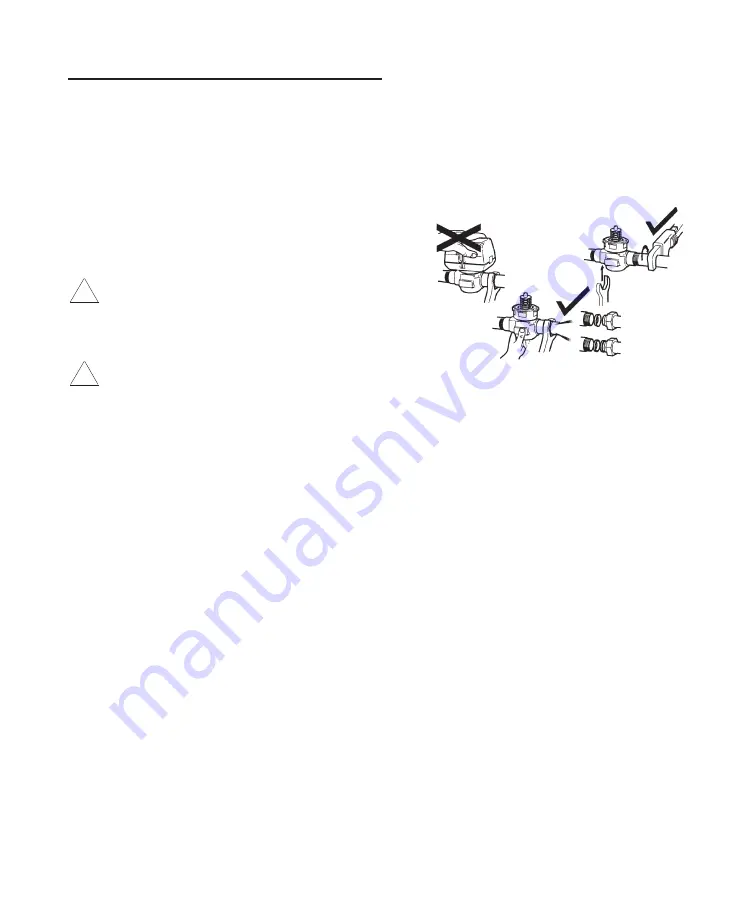
INSTALLATION
WHEN INSTALLING THIS PRODUCT:
1.
Read these instructions carefully. Failure to follow them could
damage the product or cause a hazardous condition.
2.
Check the ratings given in the instructions and on the product to
make sure the product is suitable for your application.
3. Installer must be a trained and experienced service
technician.
4.
Always conduct a thorough check-out when installation is
completed.
5.
While not necessary to remove the actuator from the body,
it can be removed for ease of installation. The actuator can
be installed in any of the four orientations to suit the most
convenient wiring direction. Actuator latching mechanism works
only when the lengths of the actuator and the valve body are
parallel to each other.
PLUMBING
The valve may be plumbed in any angle, including vertical piping,
but preferably not with the actuator below horizontal level of the
body. Make sure there is enough room around the actuator for
servicing or replacement.
3
For use in diverting applications, the valve is installed with the flow
water entering through bottom port AB, and diverting through end
ports A or B. In mixing applications the valve is installed with inlet
to A or B and outlet through AB.
Mount the valve directly in the tube or pipe. Do not grip the
actuator while making and tightening up plumbing connections.
Either hold valve body in your hand or attach adjustable spanner
(38 mm or 1-1/2") across hexagonal or flat faces on the valve body
(Figure 4).
If assembling valve train on a bench, take care not to deform body
with vice.
Do not place the raised "H" logo between the jaws of
the vice.
Excess jaw force can deform the body.
COMPRESSION MODELS
For compression fitted models, tighten the compression nuts
enough to make a watertight seal. TAKE CARE NOT TO OVER
TIGHTEN. Maximum torque limit is 33 ft-lb for the 22 mm
compression fitting, and 48 ft-lb for the 28 compression fitting.
SWEAT MODELS
On sweat fitted valves, the cartridge is shipped loose to avoid
being damaged during the solder operation.
1.
Remove valve actuator from body and solder the connecting
pipes in accordance with normal soldering practices.
2.
After soldering and valve has cooled, remove cartidge assembly
from plastic bag, insert into the valve body and tighten down
with enclosed wrench until it bottoms out. DO NOT OVER
TIGHTEN (maximum torque is 40 in-lb). See Figure 5.
3.
Replace valve actuator.
TO REPLACE CARTRIDGE (IF REQUIRED)
Two-way cartridges fit all two-way bodies. The Cv rating of a valve
can be changed by replacing the cartridge, allowing for unique
combinations. Three-way cartridges fit all three-way bodies.
Cartridges for proportional control applications have high force
springs color-coded red.
1. Disconnect power supply before servicing to avoid electrical
shock or equpiment damage.
2. Depending on the installation, it may be necessary to disconnect
leadwires to valve actuator, or depress tab on Molex™ connector
and remove. Where appropriate, label wires for rewiring.
3. Remove valve actuator by pressing up on the latch mechanism
located directly below the red manual open lever with thumb (See
Figure 5). Simultaneously press the actuator down towards the
valve body with moderate hand force and turn the actuator counter-
clockwise by 1/8 turn (45°). Lift actuator off the valve body.
!
PROPER USE:
These valves are only for use in cold, warm, and hot
water applications. They are designed for a medium
temperature range of from 34 to 203°F (1 to 95 C), at a
maximum pressure of 300 psig (20 bar). They are to be
operated with the appropriate Honeywell actuators only.
Water must be properly filtered, treated and conditioned
according to local conditions.
The presence of suspended particulate(s) in the system,
such as detached calcium scale, sand, silt, large
quantities of magnetite, etc., can affect operation of
the valve. For trouble-free operation of this product,
good installation practice should include initial system
flushing, chemical water treatment, and the use of a
50 micron (or finer), 10% system side-stream filter(s).
Remove all filters before flushing.
Put the VC actuator manual lever in the fully up position or
the half open (down) position to allow initial system flushing
with the actuator mounted. This may be done without
electrical hook-up. Alternatively, reusable flush caps, part
# 272866B, may be purchased separately for use in initial
flushing of dirty hydronic systems.
Do not use boiler additives, solder flux and wetted
materials which are petroleum based or contain
mineral oil, hydrocarbons, or ethylene glycol acetate.
Compounds which can be used, with minimum 50%
water dilution, are diethylene glycol, ethylene glycol, and
propylene glycol (antifreeze solutions).
CAUTION:
Disconnect power supply before connecting wiring to prevent
electrical shock and equipment damage.
On 24V systems,
never
jumper the valve coil terminals, even
temporarily. This may damage the thermostat.
Figure 4 - Plumbing of the VC Valve
!
IMPORTANT:
The presence of iron oxide(red rust) in the system voids the
valve warranty.


